Maximizing Lifetime of WSN in Improving Healthcare Monitoring Sector
Info: 6539 words (26 pages) Dissertation
Published: 2nd Feb 2022
Tagged: TechnologyHealthcare
Abstract
Wireless Sensor Networks (WSNs) are self-configuring networks which consist of a large number of sensors that are small in size, low in cost and power, and are multifunctional. Sensors’ nodes are small electronic devices that have certain capabilities like sensing, computing, and data transmitting. The main energy source for these sensor nodes is the energy of batteries that is depleted at a faster rate as a result to the communication and computations’ operations that they perform. In fact, Lifetime of the whole WSN system, battery lifetime, and sensor nodes autonomy are example of problems that to be solved with regard to WSNs.
Therefore, this research aims at proposing Tabu Search and Simulated Annealing Algorithms for finding optimum route that achieves the efficiency in terms of energy consumption and throughput in Body Sensor Networks, especially for health monitoring. In order to prolong the battery life and reduce data transmission, the proposed opportunistic algorithms attempt to establish an efficient intelligent healthcare system remotely.
This objective can be achieved when each vital sign is being processed at the sensor node and sending data to a personal digital assistant just in the case of abnormal measurements. A simulation has been performed on a patient monitoring example for collecting vital signs data utilizing both algorithms and a comparison has been run to find the best algorithm that helps maximizing the network lifetime better through two main objectives; Minimizing the power consumption and maximizing the throughput.
The comparison results showed that the tabu search gives better results than Simulated Annealing in reaching the optimum route that best achieves the preferred evaluation criteria. In addition, the execution time when applying Tabu is significantly less than the time required by Simulated Annealing. Therefore, Tabu is considered more suitable for routing optimization problems.
Keywords: Wireless Sensor Networks (WSNs), Node, Tabu Search, Simulated Annealing (SA).
Table of Contents
Click to expand Table of Contents
Chapter 1: Aims and Introduction
1.1 Introduction
Chapter 2: Background and Significance
Chapter 3: Research Plan
Chapter 4: Experimental Results
4.1 Power Consumption minimization
4.2 Throughput maximization
4.3 Minimum power Consumption and maximum throughput optimization
Chapter 5: Conclusion and Future Suggestions
References
List of Figures
Figure 1: Applications of WSNs
Figure 2: Sensor node architecture.
Figure 3: Architecture of Wireless Body Area Sensor Network
Figure 4: SA Run Time
Figure 5: Tabu Run Time
Figure 6: SA and Tabu Run Time
Figure 7: SA Rune Time
Figure 8: Tabu Rune Time
Figure 9: SA and Tabu Rune Time
Figure 10: SA Run Time
Figure 11: Tabu Rune Time
Figure 12: SA and Tabu Rune Time
List of Tables
Table 1: Vital signs notation
Acronyms and Symbols
WSN - Wireless Sensors Network
WBAN - Wireless Body Area Network
GMM - Information and Communications Technology
CVDs - Cardiovascular disease
SA - Simulated Annealing
Chapter 1: Aims and Introduction
1.1 Introduction
Wireless Sensor Networks (WSNs) are self-configuring networks which consist of a large number of sensors that are small in size, low in cost and power, and are multifunctional. Sensors’ nodes are small electronic devices that have certain capabilities like sensing, computing, and data transmitting that reinforce the idea to build inexpensive Wireless Sensor Networks (WSNs). Wireless Sensor Networks have the advantage of being cooperative; since the sensors do not send raw data directly, but they use their processing capabilities to do some computations and just send the required and partially-processed data [1].
Each and every sensor in any Wireless Sensor Network depends on the energy of the battery, thus the conservation of power becomes an important concern to consider. Wireless Body Area Network (WBAN) is a kind of energy limited network since nodes may work in the field without durative power supply.
Due to the great advances that happened in the field of wireless communications and electronics, sensor nodes that are of low cost, low power and multifunctional have been greatly developed. These small devices have the capability to interact with the surrounding environment, detect the events that are intended to be measured and detected, process data and integrate them with their local environment. Those sensors are of small size, and communicate in short distances using Radio Frequency (RF), Infrared (IR) or Optical transmission medium. Wireless Sensors Networks play a significant role in gathering, collecting, extracting information for certain environmental phenomena due to their reliability, flexibility, accuracy, cost effectiveness, and ease of deployment. Also, it can help collecting information from the area of interest, especially where the physical environment is harsh such as temperature, sound, pressure, speed, humidity, and so on [2, 4].
Sensors Networks has its beneficial use in various life fields such as military, health, and home [1]. Wide range of applications with many different requirements covered with the umbrella of Wireless Sensors Networks; for example, tornado’s motion prediction, planning for road routes, fire detection in forests, exploring new sources of energy, prediction of climate change and weather, monitoring of seismic acceleration, GPS data and temperature [2, 4]. Figure (1) shows the different applications of WSNs.
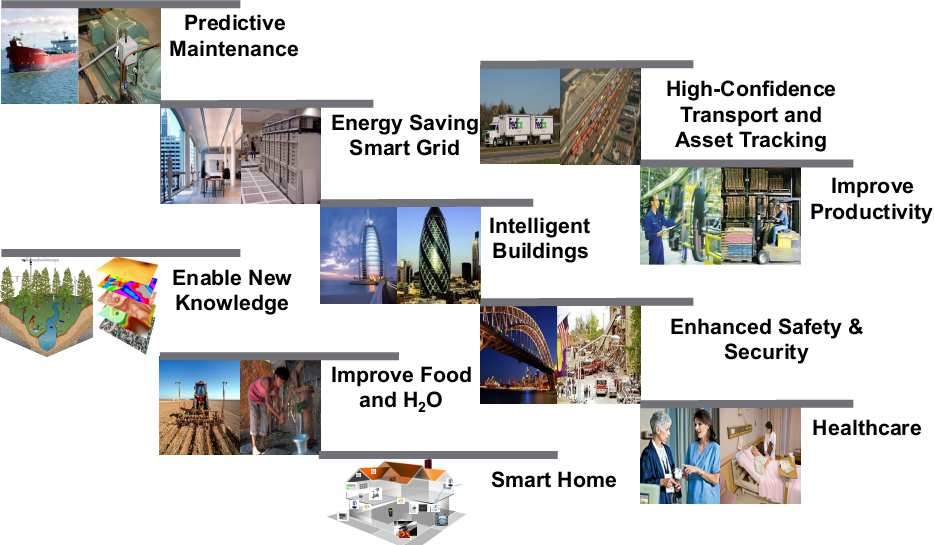
Figure 1: Applications of WSNs
Sensors are devices that operated by battery, any used protocols must consider the efficiency in energy to prolong the system lifetime. We can measure the lifetime of the network by measurable parameters such as the time until half of the nodes die, or when the network failed providing the PDA with the desired data relation to the vital signs measured [2].
Although using of wireless networks is increasing, there are still the problems in energy constraints in term of limited battery lifetime. Energy is one of the major issues in Wireless Sensor Networks because each node in the network depends on the energy for its activities. If one node failed, then the whole system will be interrupted. Every node can be under one of the following modes; active, idle, and sleep mode. In active mode, each node consumes power through receiving, processing, and transmitting the data. In ide mode, approximately the same energy as in the active mode is consumed. Finally, in the sleep mode, nodes are shutting down to keep energy [3].
In health applications, the usage of sensor networks includes but not limited to; health care monitoring, monitoring the patients inside and outside the hospital, observing physiological data for patients, remotely observe abnormal conditions for the cardiovascular disease patients, and drug administration [4].
In the operation of WSNs, energy consumption is the main concern. For most applications, WSN is inaccessible or it is not feasible to replace the batteries of the sensor nodes. The life time of the network is the maximum time for which network is operational. Therefore, if the power in the battery is limited, then lifetime of network is limited too. Power is a scarce source in WSNs because of size and cost limitations of sensor nodes [4]. Since it is required for WSNs to operate for a long time over months or even years, energy-efficient operation becomes the most important factor of the design of WSNs. Many researchers are therefore working to find power-aware operating protocols for Wireless Sensor Networks to overcome such energy efficiency problems.
The energy that is consumed by communication in Wireless Sensor Network can be saved by applying some techniques as follows: [5].
- Scheduling the mode of the sensor (active, idle, or sleep).
- Designing energy efficient data collecting methods.
- Controlling the rate of transmission between nodes in the network.
To reduce network traffic and hence conserve the battery power, data fusion process is used where there are routing protocols direct the collected data from sensors at one of sensors and that will transmit one aggregate transmission for more efficiency.
Nodes consist of a data processor, memory, and transceiver. The data processor processes the data and applies computations, data stored at the memory, the battery gives energy needed and the transceiver receives and sends data from node to another in the network as shown in figure (2). [6]
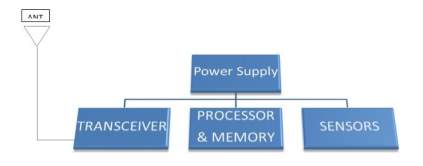
Figure 2: Sensor node architecture.
Recently, researches addressed energy consumption attentiveness and power management approaches to tackle the problem of achieving the efficient utilization of energy in WSNs. They have found that optimum routing techniques and energy optimization usage are significantly affecting the WSNs performance and prolong the network lifetime. Taking into account the consideration of power consumption, network challenges and design, there are many algorithms that were examined and used to optimize routing. Examples are Fuzzy Logic (FL), Neural Network and Artificial Immune System (AIS) [3].
Traditionally, routing is based on the concept of selecting a single node to be the next point for receiving data packets. To avoid the wireless losses, Opportunistic routing was developed. In this way when one of the sensors sends data packets, then any sensor that sense the data transmission may come and forward it [7].
Vupputuri et al. [8], with aiming to maximize the network lifetime of a Wireless Sensor Network (WSNs), have proposed a mobile data collector (DC); Data collectors can change their locations while knowing that their movement can be monitored and controlled. In a predefined times, each sensor node sends data packets to its nearest DC. The data that comes from the sensor nodes are collected by DCs and being sent to the base station BS. The network lifetime is maximized by locating the DCs in such a way that the forwarding load is distributed among the sensor nodes.
When the node is closer to the sink node, more energy is being consumed [9]. Therefore, data collectors (DCs) should find a way to relocate dynamically according to the energy of different parts of the network. Data collectors move toward the area of high energy. However, there is a problem that when the DC becomes out of work, the cluster also won’t work anymore.
1.2 Problem Definition
Most information and communications technology (ICT) systems and application in healthcare and medical area aims at increasing the quality of healthcare monitoring system and reducing the costs through the less energy less energy utilization without compromising the quality of provided service. Aging population is the major highlighted concern that needs an efficient healthcare system. The number of people who are over 60 is estimated to increase from 11% to 22 by the year 2050. Cardiovascular diseases (CVDs) lead to death globally since the serious and dangerous nature of the disease. According to World Health Organization (WHO), 17.5 million of people died in 2012 from such CVDs as heart attack or stroke, and expect this number to increase. Thus, the Elderly and chronic disease patient requires continuous health monitoring.
The development of the micro-electro-mechanical system (MEMS) technology, wireless communications and enormous growth of computing the power improves the quality of the healthcare area services. Wireless Sensor Network (WSN) or Wireless Body Area Network (WBAN) is the key source for the actual cost through the utilization of power for the system for both the healthcare professionals and patients.
Typically, WBANs are used in vital signs, monitoring gait and posture monitoring fall detections fitness or activity level etc. By using these systems, healthcare is being delivered to patients not only in hospitals and medical facilities, but also in their homes or workplaces. The main advantage of such a system is mobility. Patients can move freely and perform daily tasks while being monitored, thus reducing the number of patient visits to the hospital or to the medical facilities. Using WBAN technology, several tiny, lightweight and low power sensors are being attached to the patient’s body. Those sensors can collect physiological measurements of vital signs like body temperature, electrocardiogram (ECG), blood pressure, heart rate, etc. Such non-invasive sensors can communicate wirelessly with a personal server (personal digital assistant (PDA) or mobile phone) and transmit the collected data to a remote server, for diagnostic and health purposes, from where it can be consulted by a physician on a graphical user interface. Another advantage of these systems is the capability of generating automatic and real-time alarms. In case of decline in health status physicians or emergency services can be alerted.
Energy saving is one critical issue for sensor networks since most sensors are equipped with non-rechargeable batteries that have limited lifetime [10].
1.3 Statement of Purpose
This research aims at proposing Tabu Search and Simulated Annealing Algorithms as routing algorithm for energy efficient routing in body sensor networks for reliable health monitoring and using it in real-time, and vital signs monitoring systems. The proposed algorithms attempt to fulfill the requirements for an intelligent and energy efficient remote healthcare system. Processing vital signs measurements on each sensor node and continuously updating vital signs thresholds according to the patient’s activity, and sending data to the personal server only when abnormal measurements are detected, can significantly reduce data transmission and save the sensors’ battery life. This research compares the performance of the body wireless Sensor Networks under both algorithms and finds the algorithm that reaches the optimum route faster.
1.4 Thesis outline
This research is presented and outlined in the next chapters as follows:
Chapter Two: Background and significance includes the literature review which presents up-to-date research conducted and findings in this field of study.
Chapter three: Research Plan presents the adopted methodology which explains the procedures that were followed to complete the pretended simulation and ensure its reliability prior to analysis.
Chapter four: Experimental results shows the results and analysis of the simulation that was done using Simulated Annealing Algorithm supported with explaining tables and figures that show the results clearly.
Chapter five: Conclusion and Future suggestions delivers some concluding remarks about the thesis work. In addition, it provides a vision and suggestions to the future improvements and modifications.
Chapter 2: Background and Significance
Akyldiz et al. [1] have conducted a survey of protocols and algorithms proposed thus far for sensor networks going through the literature to focus on the solutions that are discussed under their work. Also, they have highlighted the open research issues and introduce new interests and future possible improvements in the field.
Al-Ghamdi and El-Emary [3] in their paper have focused on the vital role of the Wireless Sensor Networks (WSNs) in the different applications such as environment, military, agriculture, health and medical field, and communication. Also, they highlighted the recent findings in the field.
Due to the importance of the lifetime of a sensor network, Kumar et al [5] have carried a survey for the different techniques that are used to enhance and prolong the lifetime of the sensor. Also, they studied the future trends in designing and manufacturing energy-efficient WSN protocols.
Since the energy resources of a wireless sensor are limited, and since recharging or replacement of battery is almost impossible or highly costs, then it becomes a must to wisely manage energy resources for wireless sensor network to extend the lifetime of networks. To achieve this target, many energy-efficient protocols were developed and used to prolong the lifetime of networks.
Taneja and Bhalla [6] proposed “an energy efficient three level hierarchical clustering protocol” for wireless sensor networks. They have built the protocol on a concept that there is a pre-defined radius around the Base Station, some nodes lies within this radius and others are outside it. The outside cluster heads find the cluster heads inside the radius and send data to it. Then the inside cluster heads accumulate the data and send it to the base station. The authors have conducted simulations to evaluate those protocols and they got good results.
Kaliszan and Stańczak [7] have considered the problem of designing an energy-efficient routing scheme for WSN. They have suggested an optimization framework for maximizing lifetime of a network using opportunistic routing in parallel with random linear network coding. They proposed that each node tries to receive transmissions from a given neighbor, and thus consumes energy for receiving, with a certain probability.
Aiming to maximizing the lifetime of a wireless sensor network, Vupputuri et al. [8] have utilized mobile Data Collectors (DCs) without compromising on the reliability requirements. The DCs have locomotion capabilities and their movement can be controlled. Each sensor node periodically sends sensed event packets to its nearest DC. The DCs collect the event packets that are coming from the sensor nodes and then send these packets to the base station BS. The network lifetime is maximized by moving the DCs in such a way that the forwarding load is distributed among the sensor nodes. Also, they proposed both centralized and distributed approaches for finding a movement strategy of the DCs. In addition, they have run simulations to prove that the proposed approaches can give the reliability required and also maximize the network lifetime compared to the existing approaches.
Singaram et al. [11] aims at preserving full coverage-target area while minimizing the number of active nodes. With the assumption that the nodes in wireless sensor network consumes energy even when they are not sensing, Radio energy models are being used to find the consumed energy in the different modes of nodes like transmit, receive, idle, and sleep mode. There is a blind spot where the nodes enter the sleep stat and do not sense. The blind point can be removed using the back of mechanism and that’s the major part of the work.
Developing energy efficient routing protocol is one of the major issues in the field of Wireless Sensor Networks to prolong the lifetime of the network. One of the routing approaches that are used to achieve this purpose is the clustering approach. Tripathi et al. [12], in their paper, have proposed an Energy Efficient LEACH-C (EELEACH-C) protocol; in this protocol the base station runs a sorting algorithm to get a list of candidate cluster head nodes sorted in descending value their residual energy. After examining the candidate cluster head nodes it selects those with maximum residual energy and then calculate the quadratic sum of the distances from each cluster heads to its member nodes to find the optimal solution.
In order to increase the network lifetime, Energy-aware connectivity must be used by optimizing the power control, using particular communication mechanism, and topology control. Xenakis et al. [13] have provided an energy-aware joint power, packet and topology optimization for WSNs. They made an assumption that power control based on feedback information, packet transmission through automatic-repeat-request (ARQ) mechanism and topology control assuming specific coverage constraints. The specific joint optimization is considered as NP-complete problem and heuristic methods are used for such problems. The authors have employed Simulated Annealing (SA) for energy consumption evaluation step by step of sensor node. In each step of the SA algorithm, the resultant topology is evaluated and at the convergence point the near optimal transmit power and packet as well as node placements are obtained jointly.
Designing protocols maximizing the lifetime of a set of devices based on small and non-rechargeable batteries is considered a key challenge. As a result, Chelloug and Benmohammed [14] have used opportunistic routing is used together with random linear network coding for the purpose of maximizing the lifetime of the networks. This technique could improve wireless performance by exploiting transmission opportunities and avoiding coordination between nodes of the network. They have exploited the simulated annealing (SA) as a simple metaheuristic in order to find the optimal solution for the reception probabilities.
Wang et al. [15] have proposed an efficient approach for recovering the failure cluster by selecting multiple static sensor nodes as cluster heads to collect packets and transmit them to the sink node. This is applied in an emergent case that a mobile cluster head is broken down and therefore there will be missing packets. The objective of this approach is to recover the failure cluster and to achieve balanced energy consumption to prolong the network lifetime. To achieve uniform deployment of the cluster heads, Simulated Annealing algorithm (SA) is used. The new cluster heads are dynamically changed in order to keep energy consumption balanced based on our energy consumption model. Among the new cluster heads, packets are transmitted through multi-hop forwarding path found by Dijkstra’s algorithm, which is dynamically updated according to the energy cost of the path and current energy of the node. The experimental results show that lifetime is prolonged and the failure cluster is recovered.
Sha et al. [16] attempts to obtain the long-term average maximum throughput per energy consumption to reach the optimal energy optimization for the sensor node. They analyzed the energy conservation optimization problem in the background of cross-layer adaptive transmission over fading channels. For less energy consumption on data sensing, receiving and sending they referred to a mechanism which dynamically turns on or off different components, adjusts transmit power and modulation level of the sensor node while maintaining required performance. Then, the problem is modified by introducing dynamic power management (DPM) technique and modeled as an average reward Markov decision process (AR-MDP). The authors have proposed simulated annealing (SA) and Q learning algorithm to solve the energy conservation optimization problem with average performance criteria. The simulation shows that the energy consumption can be well balanced while the throughput of the sensor node doesn’t decrease significantly.
Chapter 3: Research Plan
Vital Signs such as ECG data, blood pressure, body temperature, and pulse oximeter can be regularly collected and remotely monitored by medical professionals to improve health caring and monitoring systems.
In this research we consider the problem of finding the optimum routing in a body sensor network for collecting vital signs for patients. We choose the following vital signs to carry the study on; ECG data, blood pressure, body temperature, and pulse oximeter. Our goal is to reach the optimum route that achieves minimum energy consumption and maximum throughput subject to a constraint on the end to end latency. The optimum route will be generated utilizing two algorithms; Simulated Annealing, and Tabu Search.
Sensor nodes are named with correspondence to the vital sign that it collect. Its names as follows
Table 1: Vital signs notation
| Sensor node name | Correspondence vital sign |
| 0 | ECG |
| 1 | blood pressure |
| 2 | body temperature |
| 3 | pulse oximeter |
| 4 | PDA |
In this work, sensors are self-organized into clusters. The clusters are randomly chosen in time which spreads energy distribution across the body sensor network. In this protocol the number of clusters is maintained low even with the increase in the nodes number. The cluster heads aggregate the data that are coming from sensors and then transmit these data to the base station. With the assumption that the base station is a PDA or some kind of monitoring screens. Figure 3 shows the architecture of body sensor network and how the sensors are randomly distributed and connected to an external base station.
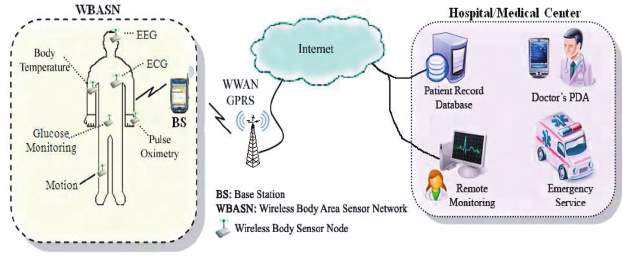
Figure 3: Architecture of Wireless Body Area Sensor Network
Since our goal is to reach the optimum route that achieves minimum energy consumption and maximum throughput subject to a constraint on the end to end latency, then those measurements must be considered as follows.
3.1 Energy Consumption maximization
For the network that consists of number of sensors, the total power consumption of all sensors must be minimized to obtain longer lifetime. Therefore, for a certain route R the energy consumption is the sum of the energy consumed at each sensor node along the route. The total energy Consumption E(R) of the route is described as:
∑i=0n∑j=0iPs*Pc* Ndi to i+1∀i,j∈n, {0,1,2,3,4}
We have applied both algorithms; simulated annealing and Tabu on the network with an evaluation function that guarantees the minimum power consumption as a criteria when generating the optimum route.
3.2 Throughput maximization
Since the monitoring of patients’ health is a very critical issue, then the data transmission to the sink should be with high frequency. Throughput is the total number of data packets that are successfully received to sink node per time unit. And we prefer to maximize throughput to keep the fluency of data to the sink with short time periods. In fact, when the maximization achieved, the energy consumption increased too.
In this regard, both algorithms were applied with an evaluation function that achieves the maximum throughput as a criterion when generating the optimum route. And in each round the time required to generate the solution under the predefined evaluation function was tabulated.
3.3 Minimum power consumption with maximum throughput optimization
As a result to the fact that the power consumption will increase if we apply maximum throughput, there is a tradeoff or an optimization between throughput and energy consumption. Therefore, we also have applied the Simulated Annealing and Tabu search algorithm taking into consideration to set an evaluation function that combines our two objectives to reach the most optimum route that achieves our goal.
We performed simulation using simulated annealing and Tabu search algorithms were here used as algorithms for solving a multi-objective optimization simultaneously to combine our two conflicting objectives.
Chapter 4: Experimental Results
The simulation for applying the two-chosen multi-objective algorithms was conducted in three phases. First is when power consumption minimization is the evaluation criteria, second is when throughput maximization is the evaluation criteria, and third when the two criteria are required. The simulation was conducted on statistical data and the results were as follows:
4.1 Power Consumption minimization
A statistical analysis has been conducted to compare the TABU and SA in the purpose of finding the optimum route while considering the criteria of maintaining minimum power consumption. Firstly, Simulated Annealing was executed on statistical data and the following chart represents the run time in milliseconds that was needed to reach the optimum or near optimum route. The following chart represents SA algorithm run time.
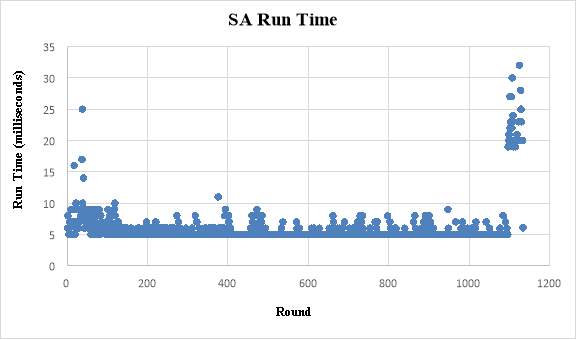
Figure 4: SA Run Time
Then, the same data was conducted to Tabu search algorithm for the same purpose and same evaluation criteria. The following chart represents the Tabu Search algorithm run time.
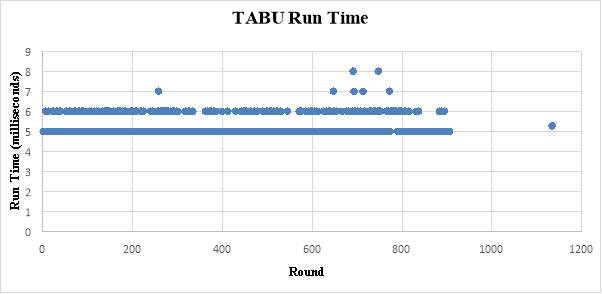
Figure 5: Tabu Run Time
The Following chart compares the performance of simulated annealing and Tabu Search algorithms. Figure (6) demonstrate that Tabu Search algorithm reached the optimum route while achieving minimum power consumption faster than simulated annealing algorithm.
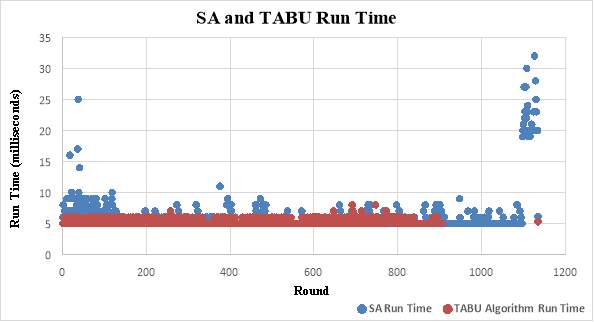
Figure 6: SA and Tabu Run Time
The total overall time of one round trip is defined as the overall travelling time from the base station to each node and returning back to the BS plus the stopping time at each checkpoint, once, to collect data. As shown in Figure (6), the Tabu search algorithm with four sensor nodes took an average time of 5.27 min per one round of data collection while 6.07 min were recorded for the SA.
4.2 Throughput maximization
For the purpose of maximizing throughput, the data was also subjected to the algorithms. Simulated annealing firstly was applied in the purpose of finding the optimum route while considering the criteria of maximizing throughput. Figure (7) shows the SA run time in milliseconds that was needed to reach the optimum or near optimum route.
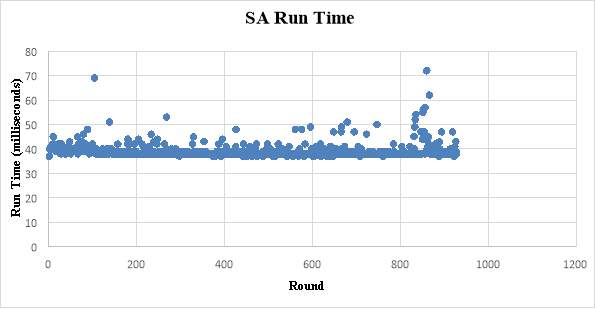
Figure 7: SA Rune Time
Then, the same data was conducted to Tabu search algorithm for the same purpose and same evaluation criteria. Figure (8) below represents Tabu Search algorithm run time.
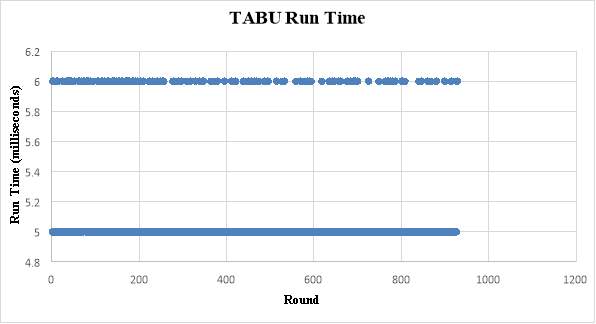
Figure 8: Tabu Rune Time
Figure (9) represents a comparison for the performance between simulated annealing and Tabu Search algorithms. The chart demonstrates that Tabu Search algorithm reached the optimum route while achieving maximum throughput much faster than simulated annealing algorithm.
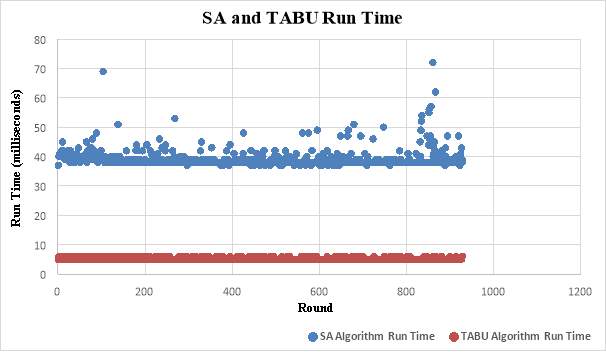
Figure 9: SA and Tabu Rune Time
As shown in Figure (9), the Tabu search took an average time of 5.17 min per one round of data collection while 39 min were recorded for the SA algorithm.
4.3 Minimum power Consumption and maximum throughput optimization
In this section, we have examined our suggested both opportunistic algorithms; Simulated Annealing and Tabu Search to solve multi-objective problem and find the best optimization between maximum power consumption and maximum throughput. Simulation was run utilizing Simulated Annealing (SA) on the data. Figure (10) shows the SA run time in milliseconds that was needed to reach the optimum or near optimum route that combines our two objectives.
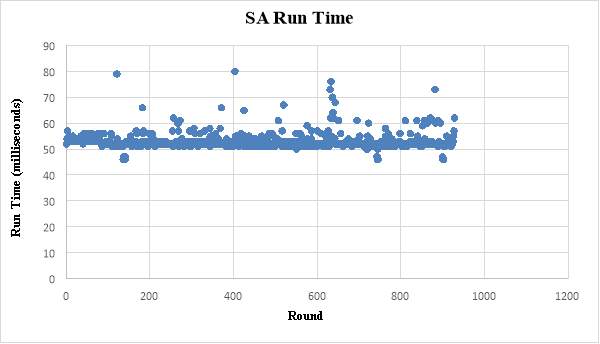
Figure 10: SA Run Time
Then, the same data was conducted to Tabu search algorithm for the two objectives that need to be optimized. Figure (11) below represents Tabu Search algorithm run time.
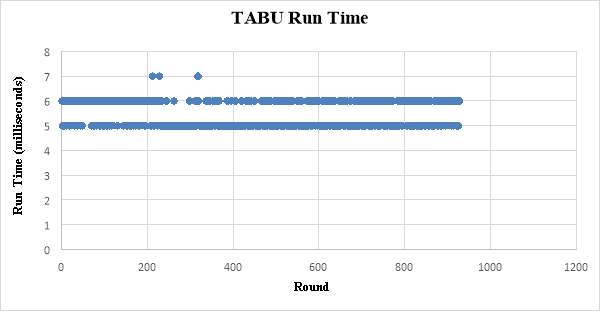
Figure 11: Tabu Rune Time
Figure (12) represents a comparison for the performance between simulated annealing and Tabu Search algorithms. The chart demonstrates that Tabu Search algorithm reached the optimum route while achieving the preferred objectives which are Minimum power consumption and maximum throughput much faster than simulated annealing algorithm.

Figure 12: SA and Tabu Rune Time
As shown in Figure (12), the Tabu search took an average time of 5.4 min per one round of data collection while 52.88 min were recorded for the SA algorithm.
Chapter 5: Conclusion and Future Suggestions
Sensor networks have become an integral part of our lives due to many flexible characteristics like flexibility, low cost, rapid deployment characteristics, and low power consumption [1]. Nowadays, WSNs have got lots of developments and widely used in the recent years but there are still some problems and challenges to deal with, including maintaining prolonged life time for the energy source of the sensors.
In this research, we proposed Simulated Annealing Algorithm and Tabu Search algorithm for energy efficient routing in body sensor networks for observing physical behavior of the patients. The goal of multi-objective optimization is to minimize energy consumption while maximizing throughput. Simulation was extensively performed on body sensor network that consists of four sensor nodes measuring ECG, blood pressure, body temperature, and pulse oximeter. The data transmits from one node to the next node and the data is aggregated and sent again to the next node and so on. Therefore the last node in the network transmits the total accumulated data to the PDA.
The performed simulation demonstrates clearly the efficiency of the used multi-objective algorithms in finding the route that combines the two objectives. The results show that Tabu search help in generation the optimum route faster than simulated annealing algorithm. The comparison results showed that the tabu search gives better results than Simulated Annealing in reaching the optimum route that best achieves the preferred evaluation criteria. In addition, the execution time when applying Tabu is significantly less than the time required by Simulated Annealing. Therefore, Tabu is considered more suitable for routing optimization problems.
References
1. A survey on sensor networks. Ian F. Akyildiz, Weilian Su, Yogesh Sankarasubramaniam, and Erdal Cayirci. 2002, IEEE Communication Magazine.
2. A Taxonomy of Wireless Micro-Sensor Network Models. Sameer Tilak, Nael B. Abu-Ghazaleh and Wendi Heinzelman. 2002, ACM Mobile Computing and Communications Review, Vol. 6, pp. 28-36.
3. Ian Akyildiz and Mehmet Can Vuran. Wireless Sensor Networks. New York : John Wiley & Sons Inc., 2010. 047003601X9780470036013.
4. Amal H. Al-Ghamdi and Ibrahim M. M. El Emary. The Vital Role of Wireless Sensors Networks in Potential Application. s.l. : MAGNT Research Report. pp. 24-33.
5. Sensors Lifetime Enhancement Techniques in Wireless Sensor Networks – A Critical Review. Karthik Sendhil Humar C., Sukumar R. and Nageswari M. s.l. : IRACST-International Journal of Computer Science and Information Technology & Security (IJCSITS), 2013, Vol. 3. 2249-9555.
6. An Improved Version of LEACH: Three Levels Hierarchical Clustering LEACH Protocol (TLHCLP) for Homogeneous WSN. Himanshu Taneja and Parvinder Bhalla. 9, s.l. : International Journal of Advanced Research in Computer and Communication Engineering, 2013, Vol. 2.
7. Maximizing Lifetime in Wireless Sensor Networks under Opportunistic Routing. Michal Kaliszan and Slawomir Stanczak. s.l. : Signals, systems and Computers (ASILOMAR), 2010.
8. Using mobile data collectors to improve network lifetime of wireless sensor networks with reliability constraints. Saamaja Vupputuri, Kiran K. Rachuri and C. Siva Ram Murthy. 7, s.l. : Hournal of Parallel and Distributed Computing, 2010, Vol. 70.
9. Efficient path planning and data gathering protocols for the wireless sensor network. Jang-Ping Sheu, Prasan Kumar Sahoo, Chang-hsin Su and Wei-Kai Hu. s.l. : Computer Communications, 2010, Vol. 33.
10. A survey of Energy Efficient Scheduling Mechanisms in sensor network. Lan Wang and Yang Xiao. 5, s.l. : Mobile Networks and Applications, 2006, Vol. 11.
11. Energy Efficient Self-Scheduling Algorithm for Wireless Sensor Networks. Singaram M, Finney Daniel Shadrach S, Sathish Kumar N and Chandraprasad V. 1, s.l. : International Journal of Scientific & Technology Research, 2014, Vol. 3.
12. Energy Efficient LEACH-C protocol for Wireless Sensor Network. Tripathi M., Guar M. S., Laxmi V. and Battula R. B. s.l. : Computational Intelligence and Information Technology, 2013.
13. Energy-Aware joint power, packet and topology optimization by simulated annealing for WSNs. Xenakis A., Foukalas F., Stamoulis G. and Khattab T. s.l. : GCC Conference and Exhibition (GCC), 7th IEEE, 2013.
14. Simulated Annealing for maximizing the lifetime of Sensor Networks under Opportunistic Routing. Samia Chelloug and Mohammed Benmohammed. s.l. : Broadband, Wireless Computing, Communication and Applications (BWCCA) 7 th international conference, 2012.
15. A balanced energy consumption solution for wireless sensor networks with failure clusters. Wei Wang, Tie Qiu, Lei Wang, Feng Xia and Guowei Wu. s.l. : Computer Science and Automation Engineering (CSAE) 2011 IEEE International Conference, 2011.
16. An energy conservation optimization strategy for wireless network node based on Q-learning. Mao Sha, Tang Hao, Zhou, and Ma Xuesen. s.l. : Control Conference (ASCC), 2011 8th Asian, 2011.
Cite This Work
To export a reference to this article please select a referencing stye below:
Related Services
View allRelated Content
All TagsContent relating to: "Healthcare"
Healthcare is defined as providing medical services in order to maintain or improve health through preventing, diagnosing, or treating diseases, illnesses or injuries.
Related Articles
DMCA / Removal Request
If you are the original writer of this dissertation and no longer wish to have your work published on the UKDiss.com website then please:




